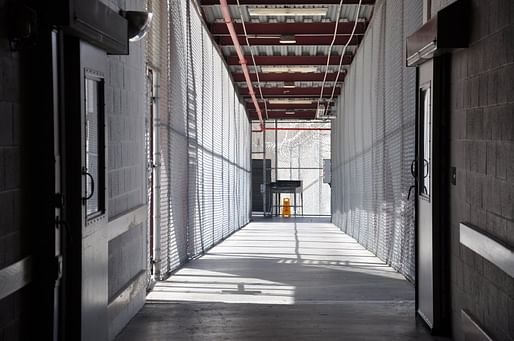

The recently passed AB-32 bill in California prevents the state from "entering into or renewing a contract with a private, for-profit prison to incarcerate state prison inmates, but would not prohibit the department from renewing or extending a contract to house state prison inmates in order to comply with any court-ordered population cap," according to the legislative text.
Under the bill, the California Department of Corrections and Rehabilitations will phase-out the department's existing contracts by 2028.The bill, once signed by California Governor Gavin Newson, is set to go into effect on January 1, 2020.
The Guardian reports that move would close all four of the state's Immigrations and Customs Enforcement (ICE) detention centers, which are run by private prison company GEO Group. The news comes as debate within the architectural profession intensifies regarding the moral and ethical implications of designing such facilities. The private prison business is booming under President Donald Trump, whose administration has vastly expanded the nation's reliance on privately-run prison and detention facilities in conjunction with increased immigration enforcement.
In recent months, the American Institute of Architects has spoken out against the "misuse" of these facilities, citing their lack of code-compliance as a key point of failure. Following the statement, many professionals questioned whether the AIA's response was forceful enough, with many individuals and groups calling on designers to boycott working on these facilities.
The Architecture Lobby (TAL)and Architects/Designers/Planners for Social Responsibility (ADPSR) issued a joint statement in response to the AIA's tepid position, writing: "[TAL and ADPSR] call on all design professionals to refuse to participate in the design and construction of any immigration detention and deterrence infrastructure, including but not limited to walls, Border Patrol Stations, Immigration and Customs Enforcement (ICE) offices, detention facilities, or juvenile holding centers."
California's move to end the use of private-run facilities in the state does little to change the state's sordid reputation for maintaining overcrowded and dangerous jails and prisons, however. A recent report from the Public Policy Institute of California, for example, found that California's prison system is running at "137.5-percent of design capacity" and that "13 of the 35 state-owned facilities individually operate beyond that capacity."
No Comments
Block this user
Are you sure you want to block this user and hide all related comments throughout the site?
Archinect
This is your first comment on Archinect. Your comment will be visible once approved.